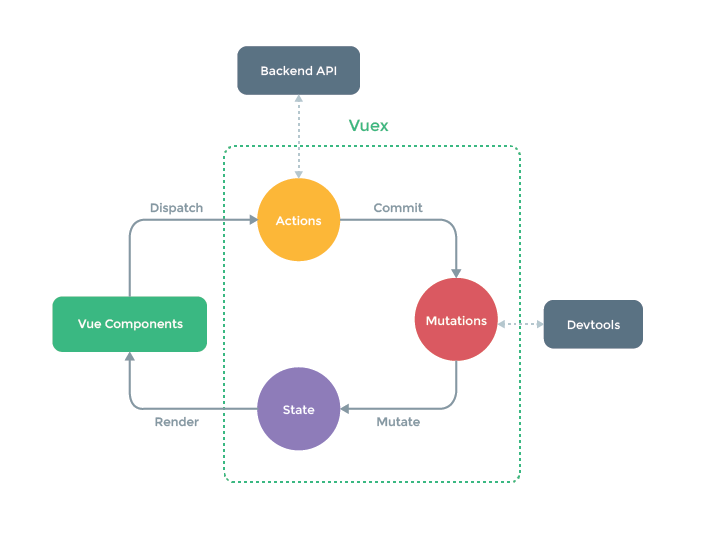Vuex
1.vuex 是什么?
- 概念:专门在 Vue 中实现集中式状态(数据)管理的一个 Vue 插件,对 vue 应 用中多个组件的共享状态进行集中式的管理(读/写),也是一种组件间通信的方 式,且适用于任意组件间通信。
- Github 地址: https://github.com/vuejs/vuex
2.什么时候使用Vuex?
- 多个组件依赖于同一状态
- 来自不同组件的行为需要变更同一状态
3.逻辑图:

4.基本使用
1.具体案例
//index.js
// 该文件用于创建Vuex中最为核心的store
import Vue from 'vue'
// 引入Vuex
import Vuex from 'vuex'
Vue.use(Vuex)
// 准备actions——用于相应组件中的动作
// 业务逻辑写在action里面
const actions = {
// jia(context,value){
// context.commit('JIA',value)
// },
// jian(context,value){
// context.commit('JIAN',value)
// },
oddjia(context,value){
// console.log(state,context,value)
if(context.state.sum % 2 == 1){
context.commit('ODDJIA',value)
}
},
timejia(context,value){
setTimeout(()=>{
context.commit('TIMEJIA',value)
},500)
}
}
// 准备mutations——用于操作数据(state)
const mutations = {
JIA(state,value){
state.sum += value
},
JIAN(state,value){
state.sum -= value
},
ODDJIA(state,value){
state.sum += value
},
TIMEJIA(state,value){
state.sum += value
}
}
// 准备state——用于存储数据
const state = {
sum:0 //当前的和
}
// 创建store
export default new Vuex.Store({
actions,
mutations,
state
})
//组件Count.vue
<template>
<div>
<h1> 当前求和为{{ $store.state.sum }}</h1>
<select v-model="n">
<option :value="1">1</option>
<option :value="2">2</option>
<option :value="3">3</option>
</select>
<button @click="increment">+</button>
<button @click="decrement">-</button>
<button @click="incrementodd">当前求和为奇数再加</button>
<button @click="incrementwait">等一等再加</button>
</div>
</template>
<script>
export default {
name:'MyCount',
data(){
return{
n:1,//用户选择的数字
}
},
methods:{
increment(){
// 这里直接跳过了action(中间没有牵扯业务逻辑),所以直接用commit
this.$store.commit('JIA',this.n)
},
decrement(){
this.$store.commit('JIAN',this.n)
},
incrementodd(){
this.$store.dispatch('oddjia',this.n)
},
incrementwait(){
this.$store.dispatch('timejia',this.n)
}
},
}
</script>
2.组件中读取vuex中的数据:store.state.sum
3.组件中修改vuex中的数据:$store.dispatch('action中的方法名',数据)或$store.commit('mutations中的方法名',数据)
5.getters的使用
1.概念:当state中的数据需要经过加工后再使用时,可以使用getters加工
2.在store.js中追加getters配置
const getters = {
bigsum(state){
return state.sum*10
}
}
// 创建并暴露store
export default new Vuex.Store({
...
getters
})3.组件中读取数据:store.getters.bigsum
6.四个map方法的使用
1.mapState方法:
帮我们映射state中的数据为计算属性
computed:{
// 1.靠程序员自己写的代码
// he(){
// return this.$store.state.sum
// },
// xuexiao(){
// return this.$store.state.subject
// },
// xueke(){
// return this.$store.state.school
// },
// 2.借助mapState生成计算属性,从state中读取数据。(对象写法)
// ...mapState({sum:'sum',school:'school',subject:'subject'}),
// 3.借助mapState生成计算属性,从state中读取数据。(数组写法)
...mapState(['sum','school','subject']),
}2.mapGetters方法:
用于帮助我们映射getters中的数据为计算属性
computed:{
// 1.靠程序员自己写的代码
// bigsum(){
// return this.$store.getters.bigsum
// },
// 2.借助mapGetters生成计算属性,从getters中读取数据。(数组写法)
...mapGetters(['bigsum'])
}3.mapActions方法:
用于帮助我们生成与actions对话的方法,即包含store.dispatch(xxx)的函数
methods:{
// 1.程序员手写法
// incrementodd(){
// this.$store.dispatch('oddjia',this.n)
// },
// incrementwait(){
// this.$store.dispatch('timejia',this.n)
// }
// 2.借助mapActions生成的方法,方法会调用dispatch去联系actions(对象写法)
...mapActions({incrementodd:'oddjia',incrementwait:'timejia'})
}4.mapMutations方法:
用于帮助我们生成与mutations对话的方法,即包含store.commit(xxx)的函数
methods:{
// 1.程序员手写
// increment(){
// // 这里直接跳过了action(中间没有牵扯业务逻辑),所以直接用commit
// this.$store.commit('JIA',this.n)
// },
// decrement(){
// this.$store.commit('JIAN',this.n)
// },
// 2.借助mapMutations生成对应的方法,方法会调用commit去联系mutations(对象写法)
...mapMutations({increment:'JIA',decrement:'JIA'}),
}7.模块化+命名空间
1.目的:让代码更好维护,让更多数据分类更加明确
2.修改store.js
// 求和相关配置
const countOptions= {
namespaced:true,
mutations:{...},
getters:{
bigsum(state){
return state.sum*10
}
}
}
// 人员相关配置
const personOptions= {
namespaced:true,
actions:{...},
mutations:{...},
}
// 创建并暴露store
export default new Vuex.Store({
modules:{
a:countOptions,
b:personOptions
}
})3.开启命名空间后,组件中读取state数据:
//1.自己直接读取
this.$store.state.a.list
//2.借助mapState读取
...mapState('a',['sum','school'])4.开启命名空间后,组件中读取getters数据:
//1.自己直接读取
this.$store.getters['b/fisrtpersonname']
//2.借助mapGetters读取
...mapGetters('a',['bigsum'])5.开启命名空间后,组件中调用dispatch
//1.自己直接读取
this.$store.dispatch['b/addpersonwang',person]
//2.借助mapActions;
...mapActions('a',{increment:'oddjia',incrementwait:'timejia'})6.开启命名空间后,组件中调用commit
//1.自己直接commit
this.$store.commit['b/ADDPERSON',person]
//2.借助mapMutations:
...mapMutations('a',{increment:'JIA',decrement:'JIAN'})5.vue-router
1.相关理解
1.vue-router 的理解
vue 的一个插件库,专门用来实现 SPA 应用
2.对 SPA 应用的理解
1.单页 Web 应用(single page web application,SPA)。
2.整个应用只有一个完整的页面。
3.点击页面中的导航链接不会刷新页面,只会做页面的局部更新。
- 数据需要通过 ajax 请求获取
3.路由的理解
1.什么是路由?
1.一个路由就是一组映射关系(key - value)
2.key 为路径, value 可能是 function 或 component
2.路由分类
1.后端路由:
1.理解:value 是 function, 用于处理客户端提交的请求。
2.工作过程:服务器接收到一个请求时, 根据**请求路径**找到匹配的**函数**来处理请求, 返回响应数据。2.前端路由:
1.理解:value 是 component,用于展示页面内容。
2.工作过程:当浏览器的路径改变时, 对应的组件就会显示。2.基本路由
1.基本使用
1.安装vue-router ,命令:npm i vue-router
2.应用插件:Vue.use(VueRouter)
3.编写router配置项:
// 该文件专门用于创建整个应用的路由器
import VueRouter from 'vue-router'
// 引入组件
import About from '../pages/About'
import Home from '../pages/Home'
// 创建并暴露一个路由器
export default new VueRouter({
routes:[
{
path:'/about',
component:About
},
{
path:'/home',
component:Home
},
]
})4.实现切换(active-class 可配置高亮样式)
<router-link active-class='active' to='/about'>About</router-link>5.指定展示位置
<router-view></router-view>2.几个注意点
1.路由组件通常存放在pages文件夹,一般组件通常存放在components文件夹
2.通过切换,“隐藏”了的路由组件,默认是被销毁掉的,需要的时候再去挂载
3.每个组件都有自己的route属性,里面存储着自己的路由信息。
4.整个应用只有一个router,可以通过组件的router属性获取到。
3.嵌套路由
1.配置路由规则,使用children配置项
// 创建并暴露一个路由器
export default new VueRouter({
routes:[
{
path:'/about',
component:About
},
{
path:'/home',
component:Home,
children:[
{
// 这里不用加斜杠
path:'news',
component:News,
},
{
path:'message',
component:Message,
},
]
},
]
})
2.跳转(要写完整路径)
<router-link to='/home/news'>News</router-link>4.路由的query参数
1.传递参数
<li v-for="m in messagelist" :key="m.id">
<!-- 跳转路由并携带query参数,to的字符串写法 -->
<!-- <router-link :to="`/home/message/detail?id=${m.id}&title=${m.title}`">{{ m.title }}</router-link> -->
<!-- 跳转路由并携带query参数,to的对象写法 -->
<router-link :to="{
path:'/home/message/detail',
query:{
id:m.id,
title:m.title
}
}">
{{ m.title }}
</router-link>
</li>2.接收参数:
$route.query.id
$route.query.title 5.命名路由
1.作用:可以简化路由的跳转
2.如何使用
1.给路由命名:
export default new VueRouter({
routes:[
{
name:'guanyu',
path:'/about',
component:About
},
{
path:'/home',
component:Home,
children:[
{
// 这里不用加斜杠
path:'news',
component:News,
},
{
path:'message',
component:Message,
children:[
{
name:'xiangqing',
path:'detail',
component:Detail
}
]
},
]
},
]
})2.简化跳转:
//1.简化前写完整路径
<router-link :to="{
path:/home/message/detail',
query:{
id:m.id,
title:m.title
}
}">
//2.简化后直接通过名字跳转
<router-link :to="{
name:'xiangqing',
query:{
id:m.id,
title:m.title
}
}">6.路由的params参数
1.配置路由,声明接收params参数
2.传递参数
注意:路由携带params参数时,若使用to的对象写法,则不能使用path配置项,必须使用name配置!
3.接收参数
$route.params.id
$route.params.title7.路由的props配置
作用:让路由组件更方便的收到参数
{
name:'xiangqing',
path:'detail',
component:Detail,
// props的第一种写法,值为对象,该对象中的所有key-value都会以props的形式传给Detail组件
// props:{a:1,b:'hello'}
// props的第二种写法,值为布尔值,若布尔值为真,就会把该路由组件收到的所有params参数,以props的形式传给Detail组件。
// props:true
// props的第三种写法,值为函数,该函数返回的对象中每一组key-value都会通过props传给Detail组件
props($route){
return {
id:$route.query.id,
title:$route.query.title,
}
}
}8.router-link 的replace属性
1.作用:控制路由跳转时操作浏览器历史记录的模式
2.浏览器的历史记录有两种写入方式:分别为push和replace,push是追加历史记录,replace是替换当前记录。路由跳转时默认为push
3.如何开启replace模式:
<router-link replace ='true'>News</router-link>
9.编程式路由导航
1.作用:不借助router-link实现路由跳转,让路由跳转更加灵活
2.具体编码:
//$router的5个API
this.$router.push
this.$router.replace
this.$router.forward //前进
this.$router.back //后退
this.$router.go //可前进可后退10.缓存路由组件
1.作用:让不展示的路由组件保持挂载,不被销毁
2.具体编码:
<keep-alive include="MyNews">
<router-view></router-view>
</keep-alive>11.两个新的生命周期钩子
1.作用:路由组件所独有的两个钩子,用于捕获路由组件的激活状态。
2.具体名字:
1.activated 路由组件被激活时触发。
2.deactivated 路由组件失活时触发。
12.路由守卫
1.作用:
对路由进行权限控制
2.分类:
全局守卫、独享守卫、组件内守卫
3.全局守卫:
// 全局前置路由守卫——初始化的时候被调用、每次路由切换之前被调用
router.beforeEach((to,from,next)=>{
console.log(to,from)
// 这里用to.name==='xinwen' ||to.name='xiaoxi'
if(to.meta.isAuth){
if(localStorage.getItem('school')==='jiaoda'){
next()
}else{
alert('学校名不对,无权限查看!')}
}else{
next()
}
})
// 全局后置路由守卫————初始化的时候被调用,每次路由切换之后被调用
router.afterEach((to,from)=>{
console.log(from)
document.title = to.meta.title || '网页页面'
})4.独享守卫
beforeEnter:(to,from,next)=>{
console.log(to,from)
// 这里用to.name==='xinwen' ||to.name='xiaoxi'
if(to.meta.isAuth){
if(localStorage.getItem('school')==='jiaoda'){
next()
}else{
alert('学校名不对,无权限查看!')}
}else{
next()
}
}}独享守卫可以和全局路由后置守卫配合使用,但是独享守卫不可以与全局路由前置守卫一起使用,会发生覆盖的情况。
5.组件内守卫
// 通过路由规则,进入该组件时被调用
beforeRouteEnter(to,from,next){
console.log(to,from)
if(to.meta.isAuth){
if(localStorage.getItem('school')==='jiaoda'){
next()
}else{
alert('学校名不对,无权限查看!')}
}else{
next()
}
},
// 通过路由规则,离开该组件时被调用
beforeRouteLeave(to,from,next){
next()
}13.路由器的两种工作模式
1.对于一个url来说,什么是hash值?——#及其后面的内容就是hsah值
2.hsah值不会包含在HTTP请求中,即:hash值不会带给服务器。
3.hash模式:
1.地址中永远带着#好,不美观
2.若以后将地址通过第三方手机app分享,若app校验合格,则地址会被标记为不合法。
3.兼容性较好
4.history模式:
1.地址干净,美观
2.兼容性和hash模式相比略差
3.应用部署上线时需要后端人员支持,解决刷新页面服务端404的问题。
6.Vue UI组件库
该部分无需笔记,直接看官方文档即可
1 .移动端常用 UI 组件库
1.Vant https://youzan.github.io/vant
2.Cube UI https://didi.github.io/cube-ui
3.Mint UI http://mint-ui.github.io
2 .PC 端常用 UI 组件库
- Element UI https://element.eleme.cn
- IView UI https://www.iviewui.co